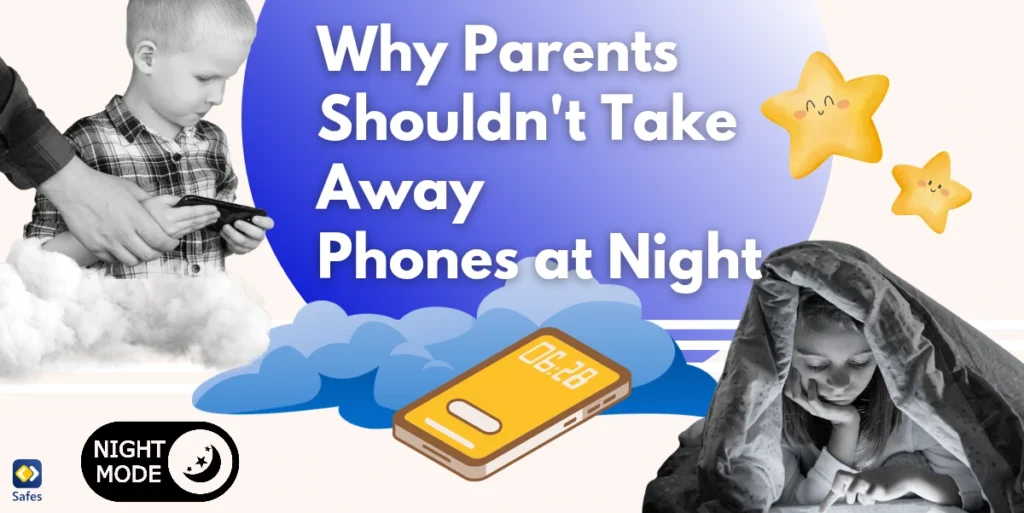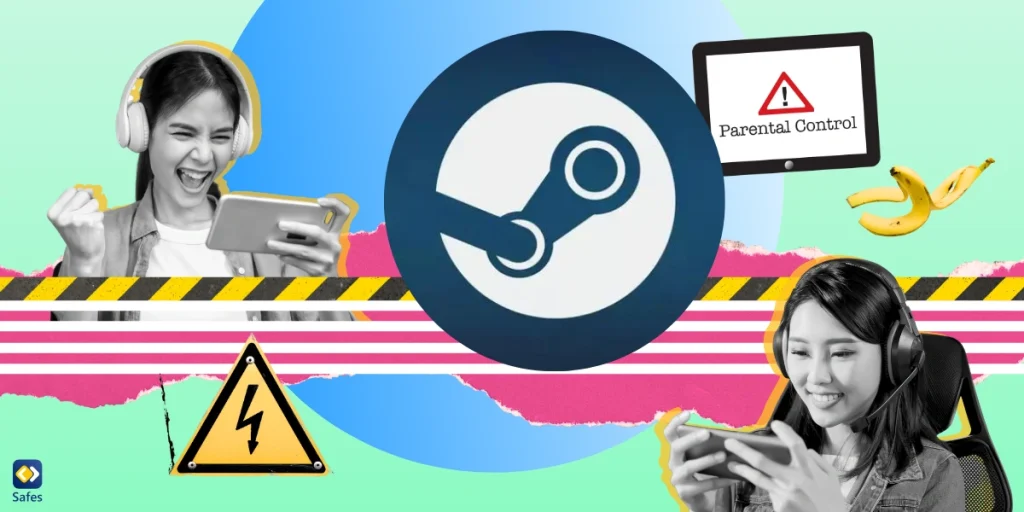For many parents, managing their child’s screen time is a delicate balancing act. Nighttime phone usage, in particular, often becomes a major concern. The temptation to simply confiscate devices at bedtime might seem like the easiest solution, but this approach could have unintended consequences. Rather than fostering healthy habits, taking away phones at night can create tension, reduce trust, and even lead to increased anxiety for kids.
Download and Start Your Free Trial of the Safes Parental Control App
This blog explores why parents should reconsider taking away phones at night, offering insights into its potential drawbacks and providing alternative strategies for promoting healthy digital habits. By understanding the psychological and emotional impact of this practice, parents can better navigate the complexities of modern parenting in a tech-driven world.
Are There Good Reasons to Take Away Children’s Phones at Night?
Taking away children’s phones at night can be justified in certain situations, primarily for health and safety reasons. One of the most common reasons is to promote better sleep hygiene. Research shows that exposure to screens before bedtime can interfere with melatonin production, making it harder for children to fall asleep. By removing phones at night, parents can encourage a more restful and consistent sleep schedule, which is essential for healthy growth and cognitive development.
Another reason is to eliminate distractions that might lead to sleep deprivation. Many children use their phones for social media, gaming, or chatting late into the night, which can impact their focus and academic performance. By taking phones away, parents can ensure that children prioritize rest over digital engagement.
The Psychological Impact of Confiscating Phones at Night
Removing a child’s phone at night may seem like a way to enforce discipline, but it can trigger unintended psychological effects. Phones have become deeply integrated into the lives of children and teens, serving as their primary connection to friends, schoolwork, and entertainment. Sudden removal can create feelings of isolation and anxiety.
Teens, in particular, rely heavily on their phones for social interaction. Taking away a phone at night could disrupt these connections, leading to feelings of exclusion or the fear of missing out (FOMO). This can create resentment toward parents, especially if the confiscation feels punitive or abrupt.
Additionally, the abrupt removal of a phone may lead to heightened stress levels. Many children use their phones to wind down at the end of the day, whether it’s by listening to music, chatting with friends, or scrolling through social media. Without access to these coping mechanisms, they may struggle to relax or fall asleep.
Instead of confiscating phones, parents can encourage healthier nighttime habits, such as limiting screen time before bed or creating a family charging station outside the bedroom. This approach maintains trust while addressing the root issue of excessive screen use.
The Importance of Building Trust and Communication
Parenting in the digital age requires a foundation of trust and open communication. Confiscating phones at night can inadvertently damage this trust, leading to strained relationships between parents and children.
When parents take away phones without explaining their reasoning or discussing alternatives, children may feel misunderstood or micromanaged. This lack of communication can hinder their willingness to share other concerns or challenges they might face.
Instead, engaging in conversations about digital boundaries and the importance of sleep fosters mutual understanding. Parents can work with their children to establish guidelines, such as limiting screen time during specific hours or enabling “Do Not Disturb” mode at night.
Collaboration is key. By involving children in the decision-making process, parents empower them to take ownership of their habits rather than viewing restrictions as imposed punishments. This approach not only preserves trust but also instills lifelong self-regulation skills.
The Role of Phones in Teenagers’ Social Lives
For teenagers, phones are not just tools but lifelines to their social world. Taking away their phones at night could inadvertently cut off their connection to friends and peers, intensifying feelings of loneliness or exclusion.
Teens often use evening hours to maintain friendships, especially in today’s fast-paced, technology-driven world. Late-night conversations can provide emotional support and strengthen social bonds, particularly during challenging times like exams or personal struggles.
While parents might view these interactions as disruptive to sleep, they also play a role in emotional well-being. Stripping teens of their access to these conversations can lead to frustration or even rebellion, as they might sneak devices or use other methods to stay connected.
A better approach is setting reasonable boundaries that respect their need for social interaction while emphasizing the importance of rest. For instance, parents can encourage teens to limit late-night chats but still allow them to check in with friends earlier in the evening.

The Risk of Overstepping Boundaries
Taking away a child’s phone at night can sometimes be perceived as an invasion of privacy. As children grow older, they crave more independence and control over their personal lives. Overstepping these boundaries can harm the parent-child relationship.
By seizing phones, parents may unintentionally convey a lack of trust. This can lead to secrecy, where children hide certain aspects of their lives or use alternative devices to bypass restrictions.
To avoid this, parents should focus on creating a balance between oversight and respect. Openly discussing concerns and setting mutually agreed-upon rules allows children to feel respected and more likely to comply with guidelines.
Respecting boundaries doesn’t mean ignoring risks. Parents can use tools like parental control apps to monitor phone activity subtly without taking away the device altogether. This ensures safety while preserving trust and autonomy.
Encouraging Healthy Sleep Habits Without Taking Phones
One of the primary reasons parents confiscate phones at night is to prevent sleep disruptions since one’s child might sleep all day and be up all night if not addressed properly. While this is a valid concern, there are more effective ways to promote healthy sleep habits without resorting to confiscation.
Parents can introduce the concept of “tech-free zones” or “screen-free hours” before bedtime. Encouraging children to wind down with non-digital activities, such as reading or journaling, helps create a relaxing pre-sleep routine.
Using built-in phone features, such as night mode or app timers, can also minimize distractions. Many devices allow users to schedule downtime, ensuring that notifications are silenced during certain hours.
Additionally, parents can lead by example by adopting similar habits. When children see their parents prioritizing offline time, they’re more likely to follow suit. Modeling good behavior reinforces the importance of a balanced relationship with technology.
Alternatives to Confiscation: Collaborative Solutions
Instead of taking phones away, parents can explore collaborative solutions that address concerns without creating conflict. Instead of confiscating phones at night, parental control apps offer a balanced approach to managing children’s digital habits. These tools allow parents to monitor and control device usage without creating conflict or resentment. Apps like Safes Family provide features such as screen time limits, app usage tracking, and bedtime schedules, enabling parents to set boundaries while fostering trust.
Parental control apps also address the root issues that lead parents to take away phones. They ensure children aren’t accessing inappropriate content or staying up too late without entirely cutting them off from their devices. This approach maintains a child’s social connections while encouraging responsible device use.
Moreover, these apps teach self-regulation by allowing children to understand and respect digital boundaries. By involving kids in the process, parents can foster a sense of responsibility and independence, leading to healthier long-term habits.
Parents can also establish shared charging stations outside bedrooms, ensuring that devices are kept in a neutral location overnight. This prevents nighttime distractions while allowing children to access their phones when needed. Parents can also shut off the internet at night.
Setting realistic goals for phone use, such as limiting screen time to a few hours per day or designating specific “phone-free” times, encourages self-regulation. These measures empower children to make responsible choices about their device usage. The key is collaboration. Working together to develop strategies fosters a sense of teamwork and mutual respect, ensuring that digital boundaries are upheld without damaging trust.
Conclusion
While the temptation to confiscate phones at night is understandable, it often creates more problems than it solves. From damaging trust to increasing anxiety, this approach can hinder rather than help a child’s well-being.
By fostering open communication, respecting boundaries, and encouraging healthy habits, parents can address concerns about nighttime phone usage more effectively. Collaborative solutions, such as parental control apps and shared guidelines, empower children to develop a balanced relationship with technology.
If you’re looking for a smarter way to manage your child’s phone usage, consider Safes Family. This powerful parental control app offers features like screen time limits, app monitoring, and downtime scheduling, helping parents guide their children toward healthier digital habits. Start your free trial today on iOS or Android and take the first step toward a harmonious digital family life!
Your Child’s Online Safety Starts Here
Every parent today needs a solution to manage screen time and keep their child safe online.
Without the right tools, digital risks and excessive screen time can impact children's well-being. Safes helps parents set healthy boundaries, monitor activity, and protect kids from online dangers—all with an easy-to-use app.
Take control of your child’s digital world. Learn more about Safes or download the app to start your free trial today!




